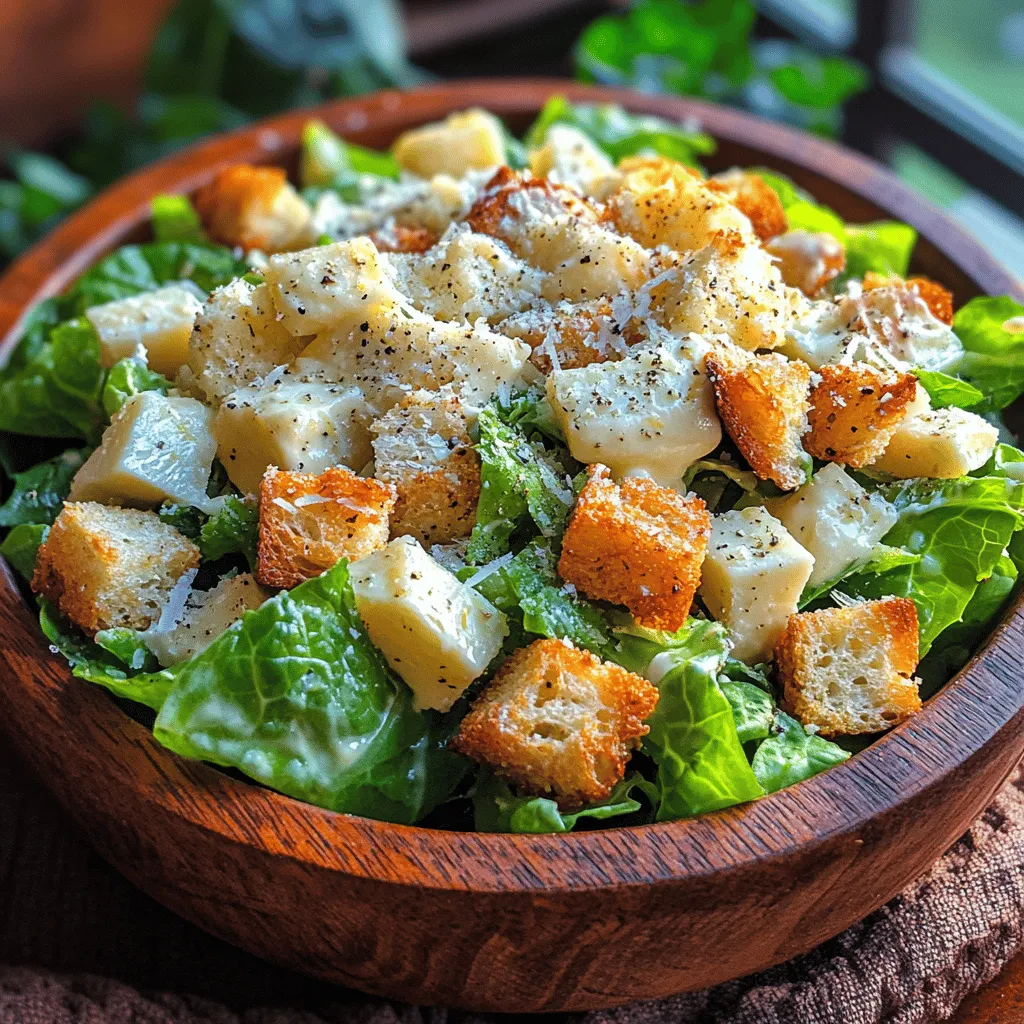Introduction
Caesar salad is a beloved classic that has graced tables for decades, known for its crisp romaine lettuce, crunchy croutons, and creamy dressing. This salad, often enjoyed as a starter or a light meal, combines fresh ingredients to create a deliciously satisfying dish. While the traditional Caesar salad is iconic in its own right, adding a unique twist can elevate this classic recipe and introduce exciting new flavors and textures. In this article, we’ll explore a fresh take on the classic Caesar salad that incorporates vibrant ingredients and homemade elements, enhancing both taste and nutrition.
The importance of using fresh ingredients cannot be overstated when preparing a Caesar salad. Fresh, high-quality produce not only boosts the flavor but also ensures that you’re getting the maximum health benefits from your meal. By making your own dressing and croutons, you can control the ingredients, avoid preservatives, and customize the flavors to suit your palate. This twist on the classic Caesar salad is not just about changing ingredients; it’s about creating a dish that is both satisfying and nourishing.
The Origins of Caesar Salad
To truly appreciate the Caesar salad, it helps to understand its rich history. The origins of this iconic dish can be traced back to the early 1920s in Tijuana, Mexico. It is believed to have been created by Caesar Cardini, an Italian immigrant who owned a restaurant in Tijuana. Legend has it that the salad was invented during a busy Fourth of July weekend when the kitchen was running low on supplies. Cardini improvised with what he had on hand, tossing together romaine lettuce, croutons, Parmesan cheese, and a simple dressing made from olive oil, egg, and Worcestershire sauce.
The classic Caesar salad is defined by its key components: crisp romaine lettuce, crunchy croutons, a creamy dressing, and a sprinkle of Parmesan cheese. Over the years, the recipe has evolved, with many variations appearing across restaurants and homes worldwide. Some versions include grilled chicken, shrimp, or even bacon, while others may substitute or add different greens. However, the foundation of the Caesar salad remains rooted in its original ingredients, emphasizing the perfect balance of flavors and textures.
Understanding the Ingredients
Overview of the Main Ingredients
To create a Caesar salad with a twist, it’s essential to start with a solid understanding of the main ingredients that will form the base of this dish.
– Romaine Lettuce: The star of the salad. Romaine lettuce is prized for its crisp texture and refreshing flavor. It’s not only delicious but packed with nutrients. Romaine is high in vitamins A and K, folate, and fiber, making it a healthy choice for salads. The crunchiness of romaine provides the perfect contrast to the creamy dressing and crispy croutons.
– Croutons: These little bites of toasted bread add a delightful crunch and texture to the salad. While store-bought croutons are convenient, making your own allows you to control the flavors and freshness. Homemade croutons can be seasoned with various herbs and spices, enhancing the overall taste of your salad.
– Parmesan Cheese: This aged cheese is a staple in Caesar salads, contributing a savory, nutty flavor that complements the other ingredients. Freshly grated Parmesan will provide a richer taste compared to pre-packaged options. Parmesan is also a good source of protein and calcium, making it a valuable addition to your salad.
Explanation of the Dressing Ingredients
The dressing is what truly sets a Caesar salad apart, and understanding its components is crucial for achieving the perfect flavor.
– Mayonnaise as a Base: While traditional Caesar dressing often includes raw eggs, using mayonnaise as a base is a popular alternative that provides creaminess without the risk associated with raw eggs. Mayonnaise also offers a rich and tangy flavor that pairs perfectly with the other ingredients. For those looking for alternatives, you can use Greek yogurt for a lighter option or vegan mayonnaise for a plant-based version.
– Lemon Juice and Dijon Mustard: The addition of lemon juice adds brightness and acidity to the dressing, balancing the richness of the mayonnaise. It enhances the overall flavor profile, making the salad more vibrant. Dijon mustard introduces a subtle spiciness and depth of flavor, further elevating the dressing.
– Garlic’s Role: Garlic is a key ingredient that enhances the flavor of the dressing. It adds a sharpness that complements the creaminess of the mayonnaise and the tanginess of the lemon juice. Fresh garlic offers the best flavor, but you can also use garlic powder in a pinch.
Optional Ingredients
To further enhance the flavors of your Caesar salad with a twist, consider incorporating optional ingredients:
– Anchovy Fillets: Traditionally, Caesar dressing includes anchovy fillets, which contribute an umami flavor that deepens the taste of the dressing. While some may shy away from anchovies, they can be a game-changer in achieving that authentic Caesar flavor. For those who prefer a vegetarian option, consider using capers or additional Worcestershire sauce for similar depth.
– Freshly Cracked Black Pepper: Adding freshly cracked black pepper just before serving can elevate the salad. It brings a slight heat and a burst of flavor that contrasts beautifully with the creamy dressing.
Step-by-Step Guide to Making Classic Caesar Salad with a Twist
Now that you understand the foundational elements of the Classic Caesar Salad with a Twist, it’s time to dive into the preparation process. This section will guide you through each step, ensuring that you create a salad that not only looks appealing but tastes incredible.
Step 1: Gather Your Ingredients
Before you begin, gather all the ingredients you’ll need. This includes:
– For the Salad:
– 1 large head of Romaine lettuce, washed and chopped
– 1 cup of homemade or store-bought croutons
– ½ cup of freshly grated Parmesan cheese
– Optional: 2-3 anchovy fillets (if using)
– For the Dressing:
– ½ cup mayonnaise
– 2 tablespoons lemon juice (freshly squeezed is best)
– 1 tablespoon Dijon mustard
– 1-2 cloves of garlic, minced
– Salt and freshly cracked black pepper, to taste
Step 2: Prepare the Dressing
1. Mix the Base: In a medium-sized bowl, combine the mayonnaise, lemon juice, Dijon mustard, and minced garlic. Whisk together until smooth and well blended.
2. Season the Dressing: Taste the dressing and add salt and freshly cracked black pepper according to your preference. If you’re using anchovy fillets, finely chop them and mix them into the dressing for an extra layer of flavor.
3. Adjust Consistency: If you prefer a thinner dressing, you can add a teaspoon of water or more lemon juice to reach your desired consistency.
Step 3: Prepare the Salad
1. Chop the Romaine: Take your washed and dried romaine lettuce and chop it into bite-sized pieces. Place the chopped lettuce in a large salad bowl.
2. Add Croutons and Parmesan: Sprinkle the croutons and freshly grated Parmesan cheese over the romaine lettuce, allowing the flavors to meld together.
3. Dress the Salad: Drizzle your homemade Caesar dressing over the salad, starting with a small amount. Toss gently to coat the lettuce, croutons, and cheese evenly with the dressing. Add more dressing if desired, but be careful not to overdress the salad.
Step 4: Serve and Enjoy
1. Finish with Seasoning: Just before serving, add a few more cracks of black pepper and an additional sprinkle of Parmesan cheese for an appealing presentation.
2. Presentation: Serve the salad immediately to maintain the crispness of the romaine and croutons. For an elegant touch, consider garnishing with lemon wedges or extra anchovy fillets.
This Classic Caesar Salad with a Twist will delight your taste buds and impress your guests with its fresh flavors and textures. With each bite, you’ll experience the crunch of the romaine, the creaminess of the dressing, and the savory notes of Parmesan cheese. Whether served as a side dish or a main course, this salad is sure to become a favorite in your culinary repertoire.
Stay tuned for the next part of this article, where we will explore additional tips for perfecting your Caesar salad and answer some common questions to enhance your salad-making experience.

Detailed Preparation of the Dressing
To create the perfect Caesar salad, the dressing is arguably the most crucial component. A classic Caesar dressing is a rich, creamy blend of flavors that enhances the freshness of the lettuce while adding depth to the dish. Here’s how to prepare it:
1. Ingredients for the Dressing:
– 1 large egg yolk
– 2 tablespoons Dijon mustard
– 2 tablespoons red wine vinegar
– 1 tablespoon Worcestershire sauce
– 1 garlic clove, finely minced
– 1 cup extra virgin olive oil
– 1/2 cup freshly grated Parmesan cheese
– Salt and freshly cracked black pepper to taste
– Optional: A squeeze of lemon juice for added brightness
2. Techniques for Whisking:
– Start by whisking the egg yolk, Dijon mustard, red wine vinegar, Worcestershire sauce, and minced garlic in a medium bowl. This combination adds a tangy base to your dressing.
– Slowly drizzle in the olive oil while whisking continuously. This technique is essential as it allows the oil to emulsify with the other ingredients, creating a creamy texture. Ensure the oil is incorporated gradually to achieve the desired consistency.
– After the oil is fully combined, stir in the grated Parmesan cheese. This will thicken the dressing slightly and add a robust flavor.
3. Tips for Seasoning and Adjusting Flavors:
– Taste the dressing as you go. It should strike a balance between tanginess from the vinegar and richness from the oil and cheese. If the dressing feels too acidic, add a bit more oil or a pinch of sugar to balance it out.
– Conversely, if it lacks zing, a little more vinegar or lemon juice can elevate the flavor profile. Always season with salt and freshly cracked black pepper, but remember that Parmesan is salty, so adjust accordingly.
Best Practices for Combining Lettuce and Dressing
Now that your dressing is ready, it’s essential to combine it with the lettuce properly to maintain its integrity and crispness.
1. Choosing the Right Lettuce:
– For a classic Caesar salad, romaine lettuce is the preferred choice due to its crunchy texture and ability to hold up well against the creamy dressing. Wash and dry the leaves thoroughly to prevent excess moisture from diluting the dressing.
2. Importance of Gentle Tossing:
– When it’s time to mix the salad, place the torn or chopped lettuce leaves in a large mixing bowl. Drizzle the dressing over the lettuce, using just enough to coat the leaves lightly.
– Using a pair of salad tongs, gently toss the lettuce with the dressing. The goal is to coat the leaves without crushing them. This gentle tossing helps maintain the crispness of the lettuce and ensures that each leaf is evenly dressed.
Incorporating Croutons and Cheese for a Well-Rounded Salad
Croutons and cheese are essential components that add texture and flavor to your Caesar salad.
1. Suggestions for Homemade Croutons:
– For a homemade touch, you can easily make croutons. Start with stale bread – sourdough or French bread works well. Cut it into cubes and toss with olive oil, garlic powder, and a sprinkle of salt and pepper.
– Spread the cubes on a baking sheet and toast them in a preheated oven at 375°F (190°C) for about 10-15 minutes or until golden brown and crispy. Stir halfway through to ensure even toasting.
2. Using Store-Bought Croutons:
– If you’re short on time, store-bought croutons can also do the trick. Look for brands that offer a variety of flavors, such as garlic or herb-infused, to add an extra layer of taste.
3. Incorporating Cheese:
– Alongside the grated Parmesan in the dressing, sprinkle additional cheese on top of the salad before serving. For an extra touch, consider using shaved Parmesan for a gourmet presentation.
Serving Suggestions and Presentation
A beautifully presented Caesar salad can make a simple meal feel special. Here are some ideas to elevate your dish:
1. Ideas for Plating:
– For an elegant look, use a large, shallow bowl to display your salad. Arrange the dressed lettuce attractively and top with croutons and extra cheese. A sprinkle of freshly cracked pepper on top adds a finishing touch.
– You can also serve individual portions in smaller bowls, which makes for a sophisticated presentation, especially for dinner parties.
2. Pairing Recommendations:
– To create a complete meal experience, pair your Caesar salad with grilled proteins, such as chicken, shrimp, or salmon. These additions not only enhance the dish but also provide a satisfying source of protein.
– A light soup, such as minestrone or tomato basil, complements the Caesar salad beautifully, making for a balanced meal.
Discussion on Variations and Customization Options
One of the great things about Caesar salad is its adaptability. Here are some variations to consider:
1. Adding Proteins:
– For a heartier meal, consider adding grilled chicken breast, shrimp, or even grilled steak. These proteins add substance and enhance the flavor profile. Simply season and grill your chosen protein, then slice and place it on top of the salad.
2. Vegetarian Adaptations:
– For a vegetarian version, skip the anchovies traditionally found in many Caesar dressings or replace them with capers for a similar umami flavor. You can also add chickpeas or white beans for protein and heartiness without meat.
Health Benefits of Caesar Salad
Incorporating fresh salads like Caesar salad into your diet offers numerous health benefits:
1. Nutritional Analysis:
– Romaine lettuce is low in calories but high in vitamins A, C, and K, as well as folate. The dressing, while rich, can be made healthier with a few adjustments, such as using Greek yogurt instead of mayonnaise for creaminess without excessive calories.
2. Advantages of Incorporating Fresh Salads:
– Fresh salads are an excellent way to incorporate more vegetables into your diet. They provide essential nutrients and can aid in digestion due to their fiber content.
3. Making the Recipe More Health-Conscious:
– To make your Caesar salad more health-conscious, consider reducing the amount of oil in the dressing or using a lighter base such as yogurt. Additionally, you can limit the amount of cheese or use a low-fat cheese alternative.
Conclusion
The timeless appeal of Caesar salad lies in its simplicity and versatility. By adding your personal twist, you can transform this classic dish into something uniquely yours. Whether you stick with the traditional recipe or experiment with various proteins and flavors, the joy of preparing and enjoying a homemade Caesar salad is unmatched.
Encouraging readers to experiment with the recipe can lead to delightful discoveries in the kitchen. So, gather your ingredients, whip up the dressing, and create a salad that not only satisfies but also sparks joy and creativity in your culinary journey. Happy cooking!

